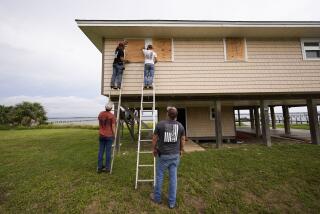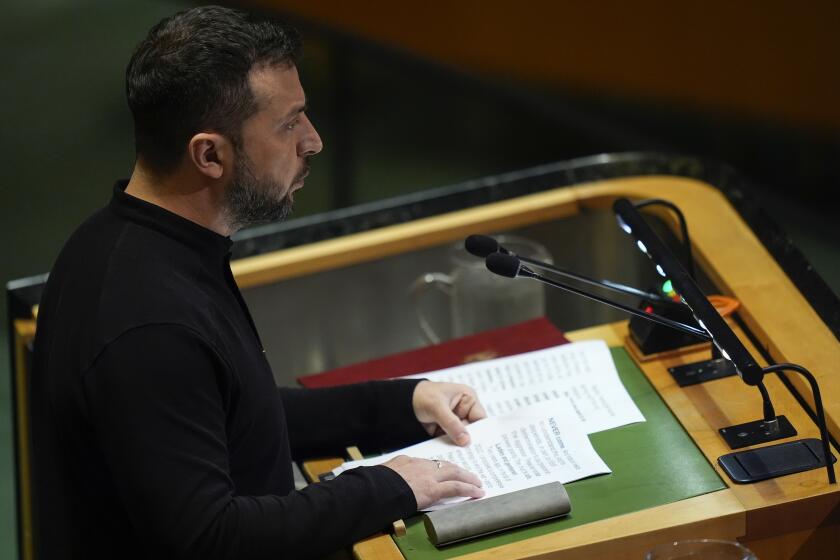Skid row effort hits a wall
The LAPD’s campaign against drug dealing on skid row arrived this month at the apartment of an alleged street-corner dealer. Police found $135,035 -- including about $6,000 in quarters, nickels and dimes.
The arrest was immediately felt on the street, “because people couldn’t find their drugs,” said LAPD Capt. Jodi Wakefield.
The arrest underscores skid row’s reputation as L.A.’s bazaar for street drugs. But despite the find, the police department’s 18-month effort to clean up the streets of downtown has reached a crossroads.
After more than a year of rising arrests and declining crime, skid row and surrounding areas have seen both level off since the beginning of 2008. Although violent crime has remained flat, property crime is up nearly 60% over last year.
Downtown officials and residents are quick to note that the uptick needs to be taken in context. The streets of skid row are still far safer now than they were two years ago.
But there is some concern about the much-publicized cleanup campaign slowing down -- and what comes next.
“We see it with our own eyes,” Estela Lopez, head of the Central City East Assn., said of the new numbers. “This is a good time to sit down and say, ‘Where are we going from here?’ ”
The police crackdown had coincided with increased gentrification on the edges of skid row, with residents moving into upscale lofts, and a variety of trendy bars, eateries and galleries opening up.
LAPD officials see a connection, saying the jump in property crimes is a result mostly of new shoppers, club-goers and others coming into the area. LAPD Lt. Paul Vernon said many of the thefts from cars were a result of people leaving expensive electronics in plain sight in their vehicles.
“They are an attractive nuisance in an area where people are desperate for narcotics and will steal anything they can sell for a few bucks,” Vernon said. Often those whose cars are broken into have chosen to park on the street outside parking lots at night, he said.
Eighteen months ago, the city of Los Angeles brought a long-promised strike force to skid row, with the pledge of creating a safer city in the process. Fifty additional police officers, on bike and foot, fanned out across the area, where drug dealers, prostitutes and thieves often operated openly on the streets. Prosecutors, parole officers and trash crews were also part of the effort, known as the Safer City Initiative.
Similar endeavors had already had some success in lowering crime rates in MacArthur Park and the north Valley, and Los Angeles Police Chief William J. Bratton promised that the skid row initiative would target “the criminal element, which preys upon the homeless and mentally ill.”
While some skid row activists decried what they called overly aggressive tactics used by police, others in the area praised the efforts as nothing short of transformational. The initiative had an almost immediate effect on crime, and the area saw a dramatic decrease in the number of homeless encampments.
But so far this year, arrests are down 12% in downtown. Fewer and fewer people have been attending the monthly “triage” meetings for the public and private groups supporting the Safer City effort.
And while the number of homeless people and encampments seems to be holding steady after the initial drop, according to statistics from the LAPD, some business owners are complaining that they are a seeing a dramatic rise in encampments and trash in the area.
George Kelling, author of the “broken windows” theory that Safer City is based on, said he expected arrests to drop as behavior on the streets changes.
Kelling, along with James Q. Wilson, have long held that targeting lesser offenses leads to reductions in major crimes. Kelling argued to the LAPD that rather than removing homeless people wholesale from the streets, police should focus on criminals, including drug dealers and prostitutes, who create a “culture of lawlessness” in the area.
“My hope is arrests would go down for minor offenses after you make an initial investment in policing an area,” Kelling said. “After a period of time, the idea is the change in behavior.”
There is some debate about why arrests are down.
“Maybe it’s just that we are reaching a point where they don’t have to arrest as many people,” said Jim Howat, Los Angeles group director of homeless services for the Volunteers of America. “That would be my hopeful thinking.”
Deputy Chief Sergio Diaz said that for much of last year, the department deployed its entire “buy bust” teams to the downtown area.
Those teams have since been moved to other areas, and narcotics arrests are down throughout the city.
Wakefield said the initial wave of arrests by Safer City officers created an immediate drop in crime, especially violent crime in the area, and her officers are still seeing the lasting effects on the streets.
“Our numbers were so good before, it’s hard to beat,” she said.
The downtown crackdown has also been contending with a change in personnel. Andrew Smith, the popular leader of LAPD’s Central Division, who was widely praised by Bratton and downtown leaders for the early success of the initiative, was promoted from captain to commander last year and recently left downtown altogether to go to LAPD’s South Bureau.
The decline in arrest numbers has not reduced criticism of the LAPD by some advocates for the homeless, who have argued that Safer Cities has resulted in more harassment of homeless people.
They say the city needs to spend less on policing and more on social services and housing to help transients get out of skid row.
Alice Callaghan, of Las Familias del Pueblo, said she has seen no drop off in police presence, which she described as “a pretty ruthless assault throughout this community on poor people because they are unsightly. The city is not prepared to spend the money on real solutions.”
LAPD officials said they are in skid row to stay.
Wakefield said she has received assurances from Bratton that the 50 extra officers assigned to her division would remain in place for the indefinite future.
Were they to leave now, she said, things would “go back to the way they were. And at this point, it is still vulnerable. We have to monitor and make sure people know we are there.”
richard.winton@latimes.com
--
(BEGIN TEXT OF INFOBOX)
Downtown crime
Property crimes in LAPD’s Central Division are up compared to this time last year, while violent crimes are down slightly. Property crimes have risen sharply in the skid row area of downtown.
Violent crimes
*--* -- Skid row -- Central Division -- Year to 1-year Year to 1-year -- date* % change date* % change -- Homicides 0 0% 1 0% Rape 2 0% 12 +33% Robbery 55 +22% 125 +16% Aggravated 61 -14% 112 -19% assaults -- Total 118 0% 250 -2% *--*
Property crimes
*--* -- Skid row -- Central Division -- Year to 1-year Year to 1-year -- date* % change date* % change -- Burglary 25 +317% 97 +102% Grand theft auto 16 -16% 113 -3% Theft from auto 53 +104% 260 +50% Other theft 73 +35% 329 +10% Total 167 +59% 799 +25% *--*
--
*Through April 5
--
Source: LAPD
More to Read
Sign up for Essential California
The most important California stories and recommendations in your inbox every morning.
You may occasionally receive promotional content from the Los Angeles Times.











